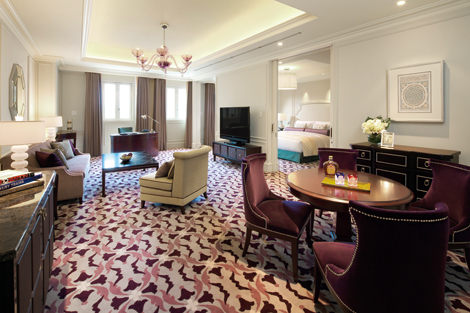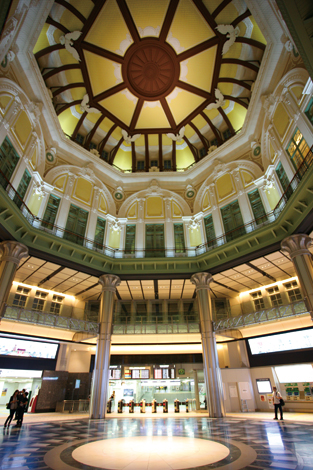Home to 13 million people, Tokyo is one of the most vibrant and lively cities on the planet. The energy here feels unstoppable – Tokyoites may work hard, but they also know how to eat, drink and shop. If you have been to districts such as Ginza, Shinjuku or Shibuya, you’ll know exactly what we mean.

The Japanese capital is sprawling, and can be visited countless times before its many options are exhausted. The expansive train network is no doubt the easiest and most affordable way to get around – especially considering that a short cab ride can easily cost US$30 – but the number of stations and confusing network are daunting. So instead of getting lost on the subway, why not focus on one or two stations to learn more about Tokyo?
The metro’s main stations are like destinations in their own right. All of them are connected to maze-like malls and hotels, and half a day can easily pass while exploring them. If you only have a few hours to spare and don’t want to waste them on a train, these transport hubs have plenty to keep you busy.
Perhaps the most striking of all is Tokyo Station. Having just celebrated its centenary, this site has been greatly expanded since the original terminal building first opened – so much so that the area is now called Tokyo Station City, encompassing leisure facilities as well as upmarket office spaces. But it’s the original structure that is its most striking aspect: it is located on the west side – or the Marunouchi side – of the complex.
The red-brick grande dame was badly damaged at the end of the Second World War, but then quickly rebuilt. The incident, however, reduced the structure from three floors to two, while its impressive dome was replaced with an angular roof. This was supposed to be a temporary measure, but was left in place until 2008, when a five-year renovation project commenced. Much of the building has now been restored to its original form.
Walk into the lobby on the Marunouchi side to admire the beautiful domed ceiling. A large portion of the area in front of the old station building has been turned into a pedestrianised piazza, a great spot for taking pictures. From here, you can also find the entrance to The Tokyo Station Hotel (tokyostationhotel.jp), opened the year after the station itself began operation. It closed for restoration in 2006 and reopened in 2012.

There are a number of dining options in the hotel. If you want to splurge, there is fine French cuisine at Blanc Rouge, which has more than 1,000 bottles of wine, including some from Eastern Japan. Take a walk up to the second floor for Sushi Aoyagi, or head to the basement for a choice of Italian, kaiseki (multi-course Japanese meal), yakitori (grilled chicken skewers) or Cantonese fare.
Alternatively, visit the Lobby Lounge for desserts, Bar & Café Camellia for casual dishes such as the signature beef stew, or Bar Oak, which opens for cocktails at 5pm.
Better yet, make this your home in Tokyo. The internet rate for a midweek stay with breakfast in the Palace Side King room in mid-March starts from ¥41,550 (US$352.50). The European-themed, 34sqm space enjoys great views of the financial district. Or raise the level of decadence to the two-storey Maisonette Twin unit, available from ¥96,430 (US$818) at the time of going to print.
There are other points of interest if you want to find out more about the station’s storied past. An original platform pillar can be found on platforms 5 and 6, on Yamanote Line and Keihin-Tohoku lines, heading in the Shinagawa and Yokohama direction. At the centre the station, on the ground floor, lies a plaque that marks the site of the attempted assassination of Prime Minister Osachi Hamaguchi on November 14, 1930. He initially survived a gunshot from an ultranationalist assailant, but died a few months later. Nine years prior to this, Prime Minister Takashi Hara, known as the “commoner prime minister” for his frugal lifestyle, was knifed and killed by a right-winger on a train journey to Kyoto. The plaque that commemorates this incident is located behind the hotel.
Located in the northern end of the old terminal building is Tokyo Station Gallery (ejrcf.or.jp/gallery). Founded in 1988 with the objective of offering visitors a venue to appreciate arts and culture in a historical setting, it hosted 105 exhibitions before it closed temporarily in 2006 for renovation. It has since reopened, operating Sundays to Thursdays from 10am-6pm (and until 8pm on Fridays). It is currently running the “Tokyo Station: A Hundred Years of its Legacy” exhibition, until March 1. Admission is ¥900 (US$7.60) per person.

In the modern part of the station, retail and yet more dining are on the agenda. Other than being home to Daimaru department store, it is also linked to the labyrinth that is the underground Yaesu Shopping Mall. There are 180 outlets here, including 60 restaurants. A confluence of noodle joints form what the locals call “Ramen Street”, and many of them are packed with customers throughout the day, especially on the weekend.
The first thing to do when visiting this place is to find the customer-service centre and pick up a map, which has information in English. Trust us, you’ll need it. We visited one afternoon on a long weekend when the place was heaving. But even among the constant stream of shoppers, one place stood out: Rokurinsha (rokurinsha.com, Japanese only). While nearby ramen shops were all moderately busy – it was mid afternoon – this place had at least 30 people waiting outside and we decided to join them. If it’s that popular, it has to be good, right?
The signature dish here is tsukumen, thick ramen served alongside a bowl of thick soup, eaten by dipping the first into the second. You are required to purchase a ticket from a vending machine before getting your seat. Everything was in Japanese and kanji (Chinese characters), but the buttons were also illustrated with pictures of the dishes. It was a good 45 minutes’ wait before we were given a seat – and you have to share tables with strangers – and served our food. The signature tsukumen, with pork and a soy-marinated egg, turned out to be slightly disappointing: while the soup was hearty and delicious, it wasn’t very hot and the noodles were lukewarm – hardly a ramen affair to remember.
After some browsing, I also tried Karin City Beer Hall (kirincity.co.jp; in Japanese only, branch located on Sotobori Chika 2nd Street). Half a pint cost ¥480 (US$4) – slightly more expensive than a glass of wine at ¥470. If you’re after a truly local experience, there are little shops outside, underneath the train tracks. One of them I happened upon was Lad’s Dining (about three minutes’ walk from the Marunouchi North Exit; tel +81 3 6269 9315). It is part of a chain. Not surprisingly, all the customers were men, who were enjoying its pub grub with a Japanese twist. The signature dish is homemade glutinous rice flour fried chicken (¥490/US$4), and there are several pizza choices starting from ¥690 (US$6), as well as seafood paella (¥990/US$8 for a small one).
We spent half a day at the Tokyo Station and only scratched the surface. Inside there are yet more flashy shops, restaurants, the Hotel Metropolitan Marunouchi and a conference centre. Even figuring out where our hotel shuttle pick-up point was – a completely different side from that of the drop-off – took almost half an hour (the lack of English information didn’t help). But that just means we’ll have to come back for more.
Tokyo Station City at a glance
Marunouchi Station Building Area
Tokyo Station Gallery
The Tokyo Station Hotel
The Jexter Tokyo fitness club: offering wellness services and amenities including pressurised oxygen capsules
Spa Tokione: managed by high-end brand Terraké, from France
JR East Travel Service Center (7.30am-8.30pm)
Ekinaka Area (inside the station)
North Court: Gransta Dining highlighting Japanese culinary culture
Central Street: speciality stores featuring Japanese products
South Court: high-end, contemporary department store
Keiyo Street: 25 richly individualistic stores selling sweets, lunch boxes, accessories and sundry items
Gransta: passage between Marunouchi and Yaesu, with more shops and restaurants, as well as concierge and currency exchange
Nihombashi Gate Area
Sapia Tower: a research and education centre
Hotel Metropolitan Marunouchi: four stars, hotelmetropolitanmarunouchi.jp
Station Conference: offering 26 large and small rooms
Gran Gourmet: three foodie zones for casual dining, including specialised Japanese eateries in “Kitchen Street”
Yaesu Area
Gran Tokyo North Tower and South Tower: Home to 14-storey Daimaru Department Store, and offices
Gran Roof Front: a structure that looks like a “sail of light” linking the two towers with a pedestrian deck and yet more shops and another department store
Gran Age: another restaurant zone, catering to business people








